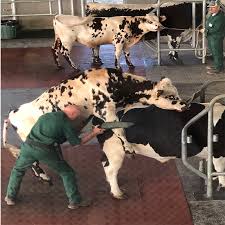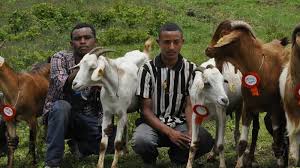As an example of how testing and selection procedures can be integrated into a genetic improvement program in livestock breeding, the national pig improvement program in Zimbabwe is described.
This program is based on a pyramidal structure a small number of registered nucleus breeders assessed to be the herds genetically in the country, send their pigs to a central performance- test station.
Approved boars and gilts pass out to multiplication herds, assessed to be the next rung down in terms of genetic merit, where their progeny is performance tested on the farm.
Animal which pass this livestock breeding test are then available to commercial producer, thus ensuring a constant supply of quality replacement stock to commercial herds.
At the central test station, pigs are housed in pens of two and fed individually and their performance is measured from 35 tropical indigenous and an imported exotic breed.
For this reason the level of heterosis will always be highest in the first (f) cross, and decrease in subsequent crosses as the genetic differences decline.
However, the overall economic gain which can be obtained from heterosis effect can be cumulative within a cross-breeding system. Thus for litter –size at weaning, for example, if the first cross dam gives a heterosis improvement of 11 per cent, and there is a further 6 per cent to be gained from her progeny’s performance, the cumulative effect is 17 per cent, or more than one additional pig weaned per litter.
There are a number of different cross-breeding strategic which can be used, all of which harness different amounts of heterosis.
Of these two breeding system, crisscross system in probably the most appropriate for the small-scale producer in the tropics. If a third pure breed is available, then this can be extended to a triple crossing system using a sire selected from each of three breeds in rotation.
Read Also: Silage Production for Livestock
Maximum heterosis is obtained when the genetic diversity, between the parent breed is large, and there is therefore considerable potential for crosses between exotic and indigenous tropical breeds.
The best use of such crosses is likely to be in semi-intensive system of production where the hardiness and foraging ability of the indigenous animal will be complemented by the growth and improved performance of the exotic.
Large number of cross-bred, animal can be found on these systems. The two main problems are the maintenance of exotic boars for generating the cross-breed, as they often fail to survive due to disease and management hazards, and the lack of breeding control, resulting in indiscriminate interbreeding.
One possible solution under condition is the use of institutionally managed boar-holding centre, such as those in some parts of the world, where indigenous sows from small-scale farmer are kept to be mated with pure-bred exotic boars.

Alternatively, private farmers with intensive production units could be encouraged to produce cross-bred progeny foe sale to small scale farmer. Similar methods could be use for the generation of exotic x indigenous boars for use on indigenous sows in small-scale production system
The benefit of heterosis in female reproductive traits can also be utilized in boars. Cross-bred boars have been shown to have greater libido, large testes and higher sperm counts than their pure-bred contemporaries, leading to more reliable breeding and improved conception rates.
This enhanced reproductive fitness is obviously likely to be a major advantage in extensive and semi-intensive production systems in developing countries.
The harnessing of heterosis is maximized in the genetic improvement schemes run by the private breeding companies in the developed world
Each company maintains a network of super-nucleus and nucleus herds in which superior genes are concentrated. These herds are subjected to strong selection pressure with rigid and comprehensive testing of stock for important trait.
Selected purebred stock from nucleus herds is then used to populate multiplier herds where improved lines and breed are crossed. The resultant first cross or hybrid gilts are sold to commercial producer.
Related: Adaptive Means of Animals Coping with the Environment

